Post by Purple Pain on Jan 16, 2021 5:18:36 GMT -6
Purple Insider's Series: The Future of the Vikings (Matthew Coller)
purpleinsider.substack.com/p/the-future-of-the-vikings-part-1
Part 1: Quarterback
Let’s begin in the most obvious place: Quarterback…
Season overview and key stats
The interesting thing about Kirk Cousins is that every year feels like a roller coaster and yet he always ends the season with about the same results.
This year Pro Football Focus ranked him as the 10th highest graded QB in the NFL. Here’s how he’s ranked every year by PFF (among QBs with at least 20% of snaps):
2020: 10th
2019: 5th
2018: 15th
2017: 20th
2016: 10th
2015: 14th
His numbers are somewhere outside of the elite but far from the terrible QBs by almost any metric designed to capture a QB’s season. Cousins finished eighth in traditional quarterback rating, 18th in ESPN’s QBR. The Vikings ranked 10th in Expected Points Added as a passing offense.
If we get out the microscope on the statistics, we can learn a little more about his season and who he is as a quarterback. For example, Cousins was the second best QB in terms of rating with a clean pocket (per PFF). The only QB better was Aaron Rodgers.
That’s consistent with previous seasons. In 2019, Cousins was fifth in clean pocket rating, 13th in 2018, 11th in 2017, eighth in 2016 and second in 2016.
There’s also enough evidence to safely say that Cousins (who said earlier this year that the QB is responsible for sacks) brings pressure upon himself.
2020: 38.6%
2019: 36.4%
2018: 38.9%
2017: 36.6%
2016: 32.0%
2015: 35.9%
Another thing that is consistent about Cousins’s game is the number of highs and lows experienced every season with the Vikings’ QB.
By PFF grades, Cousins had:
5 below average games (under 65)
7 average games games (between 65 and 80)
4 highly graded games (above 80)
His distribution by ESPN’s QBR (which gives us a percentage chance of the team to win with the QB’s performance) scored Cousins with three below average games (below 40), eight average games (between 50-70) and five highly scored games (above 75).
Altogether, we have the same story as previous season. There were a few games where Cousins drove the team to victory (i.e. @ Chicago), many games where his performance could have gone either way on the final scoreboard based on the rest of the team and a handful of games (Atlanta being the best example) where they lost because of him.
Some other notable Cousins stats:
— His performance in the second half of games vs. first half were remarkably different. He threw for 516 more yards in the second half, 15 more touchdowns and had a 114.1 rating in the second half vs. 94.3 in the first half. The most plausible explanation is that the Vikings were much more aggressive throwing the ball in the second half of games where they trailed or were close.
— Speaking of which, 64% of Cousins’s passing yards came when trailing this season
— In the Vikings’ nine losses, he had a 95.2 passer rating. That’s up from 78.3 in 2019 and 89.6 in 2018.
— Cousins lost the sixth most yards in the NFL to sacks (256)
On the matter of Cousins’s win-loss record, which is 25-21-1 in Minnesota: The Vikings signed him to his original contract an extension because they believed they would win with him at the helm. The three-year results of 25 wins, three regular season wins over teams with winning records and one playoff win are short of the goals they set.
However, Cousins had a good 2020 season and often played well enough for his team to win more than seven games. The question they have to ask is: With a big sample size of consistent play, they know what they have in Cousins. Now they should know what he needs to win.
The contract
This offseason Cousins signed a two-year, $66 million contract extension. On the third day of the league year in 2021, Cousins’s contract for 2022 becomes guaranteed, meaning if the Vikings want to cut him, they would have to do so in the first two days of the league year. That is extremely unlikely because that would mean taking a $41 million dead cap hit in 2021.
Assuming they go forward with him, Cousins will have a $31 million cap hit in 2021 (estimated around 17% of the cap) and $45 million hit in 2022. Clearly that number in 2022 is set up to force another extension. There are nine current QBs who are set to have higher 2021 cap numbers but one of them is Drew Brees, who is likely to retire and neither Aaron Rodgers, Matt Ryan or Ben Roethlisberger is going to play with hits in the $40 million range either.
Should the Vikings pull a stunning move and trade Cousins, they would still have $20 million in dead space for 2021 and $10 million dead cap in 2022.
Options
There are three routes the Vikings can go with Kirk Cousins in the future: Make him their long-term QB with another extension, draft a QB this year with an Alex Smith-like succession plan after 2021 or trade him this offseason to a QB desperate team and sign/draft another QB.
Let’s explore each option.
Make him the long-term QB
For a franchise that has struggled with stability at the quarterback position since Fran Tarkenton, signing Cousins to another extension would provide a guarantee a baseline level of performance from year to year and an opportunity to focus solely on building up around him.
This type of approach has worked for some and not for others. The Atlanta Falcons made the Super Bowl in Matt Ryan’s ninth year, for example. However, teams like the Raiders and Lions have kept Derek Carr and Matt Stafford in place with little to show for it.
The Vikings’ most likely approach would be to pour draft picks and remaining cap space into the defense with an aim on repeating a 2017-type run at some point during Cousins’s tenure.
The Alex Smith route
Here’s a quick overview on how teams with QBs on rookie contracts did this year:
Buffalo — 13-3, Josh Allen was an MVP candidate
Miami — 10-6, missed the playoffs on the final day, drafting No. 3 (via Houston)
New York Jets — Drafting No. 2 overall
Baltimore — 11-5
Cleveland — 11-5
Cincinnati — Drafting No. 5 overall
Houston — 4-12, sent their pick to Miami
Jacksonville — Drafting No. 1 overall
Kansas City — 14-2
Los Angeles Chargers — 7-9 in Herbert’s first year
Denver — 5-11, Drafting ninth
New York Giants — 6-10, drafting 11th
Chicago — 8-8, in playoffs
Arizona — 8-8, missed playoffs on final day
Out of 14 teams, five are in the playoffs, three were around .500 with their young QBs, four are drafting in the top five.
If the Vikings elected to draft a quarterback in the first round (in a draft expected to have four high-quality first-round prospects), they would aim to put the 2021 rookie in place in 2022 and hand him an offense that has been built over a number of years in the same way that Buffalo, Baltimore and Kansas City have done.
The concern is that they could end up like the New York Giants or Denver Broncos, who have developed rosters but did not succeed with their QB picks.
While not every QB turns into Mahomes, there is recent evidence to suggest that supporting cast is playing a larger and larger role in which young QBs succeed. The Rams reached Super Bowl on Jared Goff’s rookie deal and Philadelphia won the Super Bowl with Carson Wentz in his second year. Going back a few years, the Seattle Seahawks reached The Big Game twice with Russell Wilson on his first contract and Baltimore had the best record in the AFC in Lamar Jackson’s second year.
The difference between proven QBs’ contracts and rookie deals is so vast that it opens up opportunities to make win-now moves all over the roster, like the Ravens trading for Calais Campbell or Bills acquiring Stefon Diggs or Kansas City signing Sammy Watkins to an expensive free agent contract.
The formula isn’t as simple as: Draft a QB = profit. But it is an effective strategy.
Trade Cousins
If the Vikings made it known that Cousins was on the market, there are several teams that would have the cap space and need.
The New England Patriots are at the top of that list with $63 million in space per OverTheCap. They will be moving on from Cam Newton this year and getting players who opted out back.
If Tom Brady retires, Tampa Bay will be in the QB market. Dallas may lose Dak Prescott to free agency if they don’t franchise tag him again. Denver is in severe need for a QB who can throw to their top-notch weapons. And you never know what other teams might have surprises at QB.
Going this route, the Vikings could draft a QB in the first round — maybe even attempt to trade up for one — and acquire someone like Gardiner Minshew or Marcus Mariota to operate the offense in 2021/compete with the rookie.
That would put the Vikings in a similar spot as the Chargers and Dolphins were heading into this year.
Does their timeline to win match up with adding a bridge QB and a rookie and parting ways with Cousins? It does if you consider that they will have a great deal of work to do on the defensive side and have a superstar rookie receiver. It doesn’t if you consider that Mike Zimmer and Rick Spielman have been in win-now mode since 2015.
The future at QB
By far the most likely outcome for the Vikings at quarterback is that Kirk Cousins is wearing purple for a long time. But if they stay with him in 2021 and things largely remain the same, we could see a vast shift in the organization’s plans.
Overall, the Vikings got the exact version of Cousins that they should have expected and their 7-9 record is reflective of the things they put around him, including the defense, blocking and a scheme that was not focused on the passing game.
Let’s begin in the most obvious place: Quarterback…
Season overview and key stats
The interesting thing about Kirk Cousins is that every year feels like a roller coaster and yet he always ends the season with about the same results.
This year Pro Football Focus ranked him as the 10th highest graded QB in the NFL. Here’s how he’s ranked every year by PFF (among QBs with at least 20% of snaps):
2020: 10th
2019: 5th
2018: 15th
2017: 20th
2016: 10th
2015: 14th
His numbers are somewhere outside of the elite but far from the terrible QBs by almost any metric designed to capture a QB’s season. Cousins finished eighth in traditional quarterback rating, 18th in ESPN’s QBR. The Vikings ranked 10th in Expected Points Added as a passing offense.
If we get out the microscope on the statistics, we can learn a little more about his season and who he is as a quarterback. For example, Cousins was the second best QB in terms of rating with a clean pocket (per PFF). The only QB better was Aaron Rodgers.
That’s consistent with previous seasons. In 2019, Cousins was fifth in clean pocket rating, 13th in 2018, 11th in 2017, eighth in 2016 and second in 2016.
There’s also enough evidence to safely say that Cousins (who said earlier this year that the QB is responsible for sacks) brings pressure upon himself.
2020: 38.6%
2019: 36.4%
2018: 38.9%
2017: 36.6%
2016: 32.0%
2015: 35.9%
Another thing that is consistent about Cousins’s game is the number of highs and lows experienced every season with the Vikings’ QB.
By PFF grades, Cousins had:
5 below average games (under 65)
7 average games games (between 65 and 80)
4 highly graded games (above 80)
His distribution by ESPN’s QBR (which gives us a percentage chance of the team to win with the QB’s performance) scored Cousins with three below average games (below 40), eight average games (between 50-70) and five highly scored games (above 75).
Altogether, we have the same story as previous season. There were a few games where Cousins drove the team to victory (i.e. @ Chicago), many games where his performance could have gone either way on the final scoreboard based on the rest of the team and a handful of games (Atlanta being the best example) where they lost because of him.
Some other notable Cousins stats:
— His performance in the second half of games vs. first half were remarkably different. He threw for 516 more yards in the second half, 15 more touchdowns and had a 114.1 rating in the second half vs. 94.3 in the first half. The most plausible explanation is that the Vikings were much more aggressive throwing the ball in the second half of games where they trailed or were close.
— Speaking of which, 64% of Cousins’s passing yards came when trailing this season
— In the Vikings’ nine losses, he had a 95.2 passer rating. That’s up from 78.3 in 2019 and 89.6 in 2018.
— Cousins lost the sixth most yards in the NFL to sacks (256)
On the matter of Cousins’s win-loss record, which is 25-21-1 in Minnesota: The Vikings signed him to his original contract an extension because they believed they would win with him at the helm. The three-year results of 25 wins, three regular season wins over teams with winning records and one playoff win are short of the goals they set.
However, Cousins had a good 2020 season and often played well enough for his team to win more than seven games. The question they have to ask is: With a big sample size of consistent play, they know what they have in Cousins. Now they should know what he needs to win.
The contract
This offseason Cousins signed a two-year, $66 million contract extension. On the third day of the league year in 2021, Cousins’s contract for 2022 becomes guaranteed, meaning if the Vikings want to cut him, they would have to do so in the first two days of the league year. That is extremely unlikely because that would mean taking a $41 million dead cap hit in 2021.
Assuming they go forward with him, Cousins will have a $31 million cap hit in 2021 (estimated around 17% of the cap) and $45 million hit in 2022. Clearly that number in 2022 is set up to force another extension. There are nine current QBs who are set to have higher 2021 cap numbers but one of them is Drew Brees, who is likely to retire and neither Aaron Rodgers, Matt Ryan or Ben Roethlisberger is going to play with hits in the $40 million range either.
Should the Vikings pull a stunning move and trade Cousins, they would still have $20 million in dead space for 2021 and $10 million dead cap in 2022.
Options
There are three routes the Vikings can go with Kirk Cousins in the future: Make him their long-term QB with another extension, draft a QB this year with an Alex Smith-like succession plan after 2021 or trade him this offseason to a QB desperate team and sign/draft another QB.
Let’s explore each option.
Make him the long-term QB
For a franchise that has struggled with stability at the quarterback position since Fran Tarkenton, signing Cousins to another extension would provide a guarantee a baseline level of performance from year to year and an opportunity to focus solely on building up around him.
This type of approach has worked for some and not for others. The Atlanta Falcons made the Super Bowl in Matt Ryan’s ninth year, for example. However, teams like the Raiders and Lions have kept Derek Carr and Matt Stafford in place with little to show for it.
The Vikings’ most likely approach would be to pour draft picks and remaining cap space into the defense with an aim on repeating a 2017-type run at some point during Cousins’s tenure.
The Alex Smith route
Here’s a quick overview on how teams with QBs on rookie contracts did this year:
Buffalo — 13-3, Josh Allen was an MVP candidate
Miami — 10-6, missed the playoffs on the final day, drafting No. 3 (via Houston)
New York Jets — Drafting No. 2 overall
Baltimore — 11-5
Cleveland — 11-5
Cincinnati — Drafting No. 5 overall
Houston — 4-12, sent their pick to Miami
Jacksonville — Drafting No. 1 overall
Kansas City — 14-2
Los Angeles Chargers — 7-9 in Herbert’s first year
Denver — 5-11, Drafting ninth
New York Giants — 6-10, drafting 11th
Chicago — 8-8, in playoffs
Arizona — 8-8, missed playoffs on final day
Out of 14 teams, five are in the playoffs, three were around .500 with their young QBs, four are drafting in the top five.
If the Vikings elected to draft a quarterback in the first round (in a draft expected to have four high-quality first-round prospects), they would aim to put the 2021 rookie in place in 2022 and hand him an offense that has been built over a number of years in the same way that Buffalo, Baltimore and Kansas City have done.
The concern is that they could end up like the New York Giants or Denver Broncos, who have developed rosters but did not succeed with their QB picks.
While not every QB turns into Mahomes, there is recent evidence to suggest that supporting cast is playing a larger and larger role in which young QBs succeed. The Rams reached Super Bowl on Jared Goff’s rookie deal and Philadelphia won the Super Bowl with Carson Wentz in his second year. Going back a few years, the Seattle Seahawks reached The Big Game twice with Russell Wilson on his first contract and Baltimore had the best record in the AFC in Lamar Jackson’s second year.
The difference between proven QBs’ contracts and rookie deals is so vast that it opens up opportunities to make win-now moves all over the roster, like the Ravens trading for Calais Campbell or Bills acquiring Stefon Diggs or Kansas City signing Sammy Watkins to an expensive free agent contract.
The formula isn’t as simple as: Draft a QB = profit. But it is an effective strategy.
Trade Cousins
If the Vikings made it known that Cousins was on the market, there are several teams that would have the cap space and need.
The New England Patriots are at the top of that list with $63 million in space per OverTheCap. They will be moving on from Cam Newton this year and getting players who opted out back.
If Tom Brady retires, Tampa Bay will be in the QB market. Dallas may lose Dak Prescott to free agency if they don’t franchise tag him again. Denver is in severe need for a QB who can throw to their top-notch weapons. And you never know what other teams might have surprises at QB.
Going this route, the Vikings could draft a QB in the first round — maybe even attempt to trade up for one — and acquire someone like Gardiner Minshew or Marcus Mariota to operate the offense in 2021/compete with the rookie.
That would put the Vikings in a similar spot as the Chargers and Dolphins were heading into this year.
Does their timeline to win match up with adding a bridge QB and a rookie and parting ways with Cousins? It does if you consider that they will have a great deal of work to do on the defensive side and have a superstar rookie receiver. It doesn’t if you consider that Mike Zimmer and Rick Spielman have been in win-now mode since 2015.
The future at QB
By far the most likely outcome for the Vikings at quarterback is that Kirk Cousins is wearing purple for a long time. But if they stay with him in 2021 and things largely remain the same, we could see a vast shift in the organization’s plans.
Overall, the Vikings got the exact version of Cousins that they should have expected and their 7-9 record is reflective of the things they put around him, including the defense, blocking and a scheme that was not focused on the passing game.















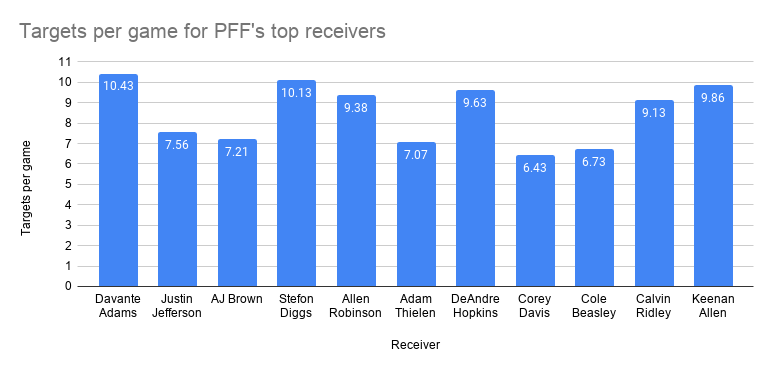
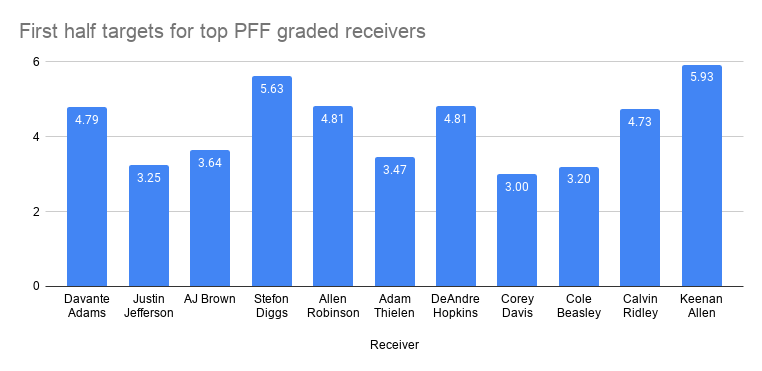
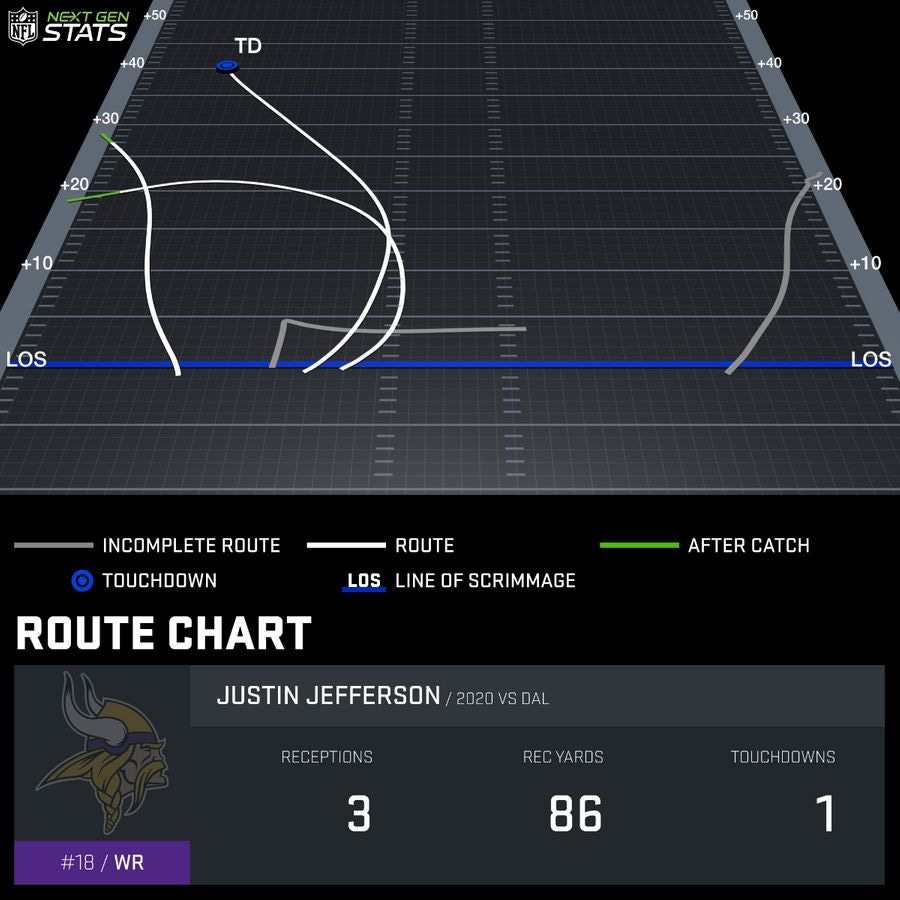
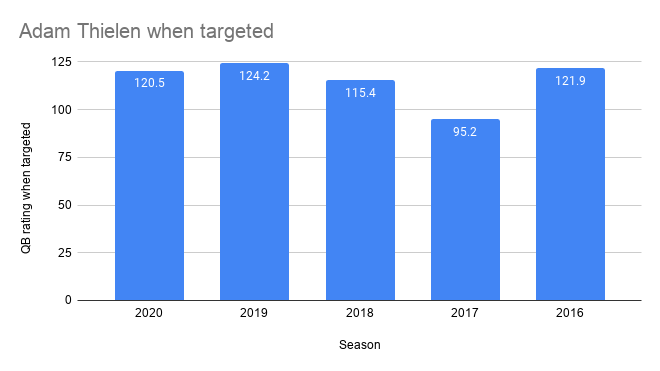

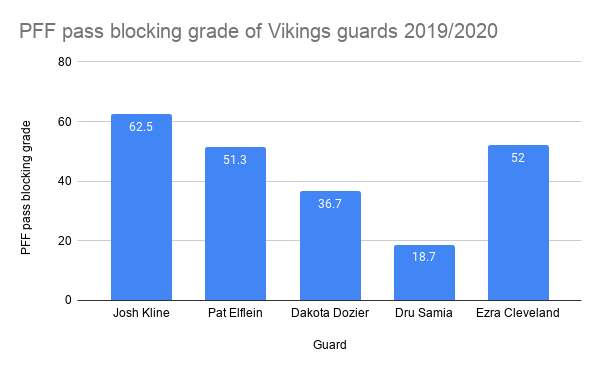
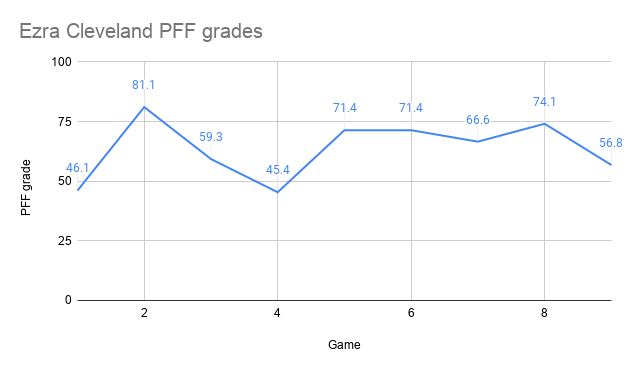




 ... and neither is this Chris guy.
... and neither is this Chris guy.